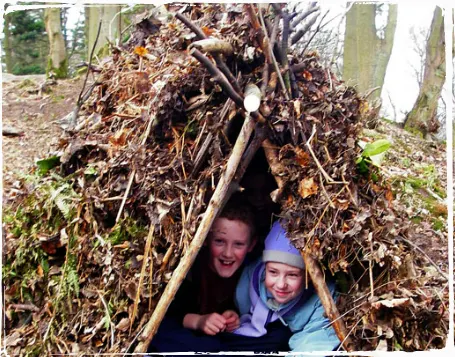survive the wild
Awaken your senses and learn what it takes to survive in the wilderness!
Students will work together and draw on the natural resources around them to build shelter, light a fire using a spark, purify water, and cook on an open fire. For senior year groups, they may even spend a night out to put their shelter and skills to the test. Students will also learn about plant identification and how they can be used.
Our bushcraft adventures take place in the real outdoors of the Yorkshire Dales and North York Moors National Parks, and the level of difficulty of surviving the wilderness is adapted to the age and level of experience of students on adventure.
What’s Included

All specialist clothing
Waterproofs and wellies when required. Ideally students should bring their own wellies, but we have plenty on hand to lend.
Transport
Once at the centre, all transport to and from adventure activities is provided.
Experienced, full-time, outdoor teachers and tutors
Each group of 12 students is led by a fully qualified and experienced outdoor tutor.
– back in the classroom –
curriculum links
Spending time in the woods provides many opportunities to bring areas of the curriculum to life, whether it is looking for mini beasts in their habitats, using maps to navigate through the maze of trees, or quietly listening and enjoying the many sounds.
Key Stage 2
Science: Living things and their habitats
Woodland adventurers have the opportunity to identify creatures – those they can see and those they can’t. They will learn about identifying their tracks and their burrows, and the importance of being careful and protecting their habitat.
Art
Art is in abundance in nature. Time can be taken to admire naturally occurring art such as tree formations, patterns in leaves, and spider webs …the possibilities go on. Students can then be inspired to create their own artwork using natural materials found around them.
Music: Birdsong
Students are encouraged to stop and take some time to quietly listen to the noises around them. Tuning into their sense of sound, students will become aware of the birdsong that surrounds them and with a little patience and curiosity, they can learn to single out and identify birds based on the sounds they make.
Key Stage 3
Science: Ecosystems
Students can learn all about the life around them – how it is connected and the fine balance that exists. Species can be identified and interactions between parts of the ecosystem can be explored, such as how microorganisms have the important role of decomposing leaf matter.
Geography: Maps
Students can be introduced to ordinance survey maps, their key features, scales, and uses. They can then be taught how to start using these as an important tool in navigation and identifying the surrounding area to them.
English: Arguments
Observing different parts of the woodland, students can break into groups and create arguments about how the woodland came to be as it is.
LOCATIONS: Offered at both Bewerley Park and East Barnby
YEAR GROUPS: Suitable for Primary and Secondary School

DURATION: Available as a full or half day activity

DIFFICULTY: Adapted to the age and level of experience of students on adventure
MIN GROUP SIZE: 12 Students
survive the wild
Awaken your senses and learn what it takes to survive in the wilderness!
Students will work together and draw on the natural resources around them to build shelter, light a fire using a spark, purify water, and cook on an open fire. For senior year groups, they may even spend a night out to put their shelter and skills to the test. Students will also learn about plant identification and how they can be used.
Our bushcraft adventures take place in the real outdoors of the Yorkshire Dales and North York Moors National Parks, and the level of difficulty of surviving the wilderness is adapted to the age and level of experience of students on adventure.
What’s Included?
All specialist clothing
Waterproofs and wellies when required. Ideally students should bring their own wellies, but we have plenty on hand to lend.
Transport
Once at the centre, all transport to and from adventure activities is provided.
Experienced, full-time, outdoor teachers and tutors
Each group of 12 students is led by a fully qualified and experienced outdoor tutor.
classroom benefits
curriculum links
Spending time in the woods provides many opportunities to bring areas of the curriculum to life, whether it is looking for mini beasts in their habitats, using maps to navigate through the maze of trees, or quietly listening and enjoying the many sounds.
Key Stage 2
Science: Living things and their habitats
Woodland adventurers have the opportunity to identify creatures – those they can see and those they can’t. They will learn about identifying their tracks and their burrows, and the importance of being careful and protecting their habitat.
Art
Art is in abundance in nature. Time can be taken to admire naturally occurring art such as tree formations, patterns in leaves, spider webs …the possibilities go on. Students can then be inspired to create their own artwork using natural materials found around them.
Music: Birdsong
Students are encouraged to stop and take some time to quietly listen to the noises around them. Tuning into their sense of sound, students will become aware of the birdsong that surrounds them and with a little patience and curiosity, they can learn to single out and identify birds based on the sounds they make.
Key Stage 3
Sceince: Ecology
Students can learn all about the life around them – how it is connected and the fine balance that exists. Species can be identified and interactions between parts of the ecosystem can be explored, such as how micro organisms have the important role of decomposing leaf matter.
Geography: Maps
Students can be introduced to ordinance survey maps, their key features, scales, and uses. They can then be taught how to start using these as an important tool in navigation and identifying the surrounding area to them.
English: Arguments
Observing different parts of the woodland, students can break into groups and create arguments about how the woodland came to be as it is.